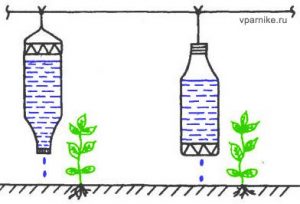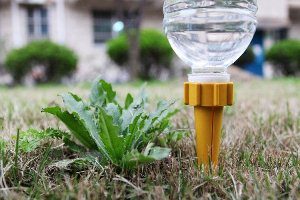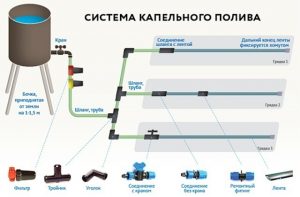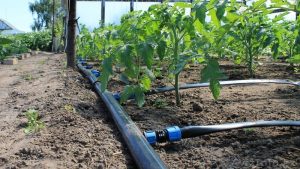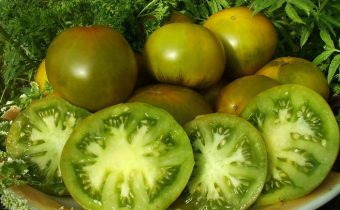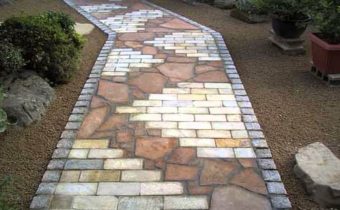Drip irrigation of tomatoes with bottles and not only: how to arrange the system
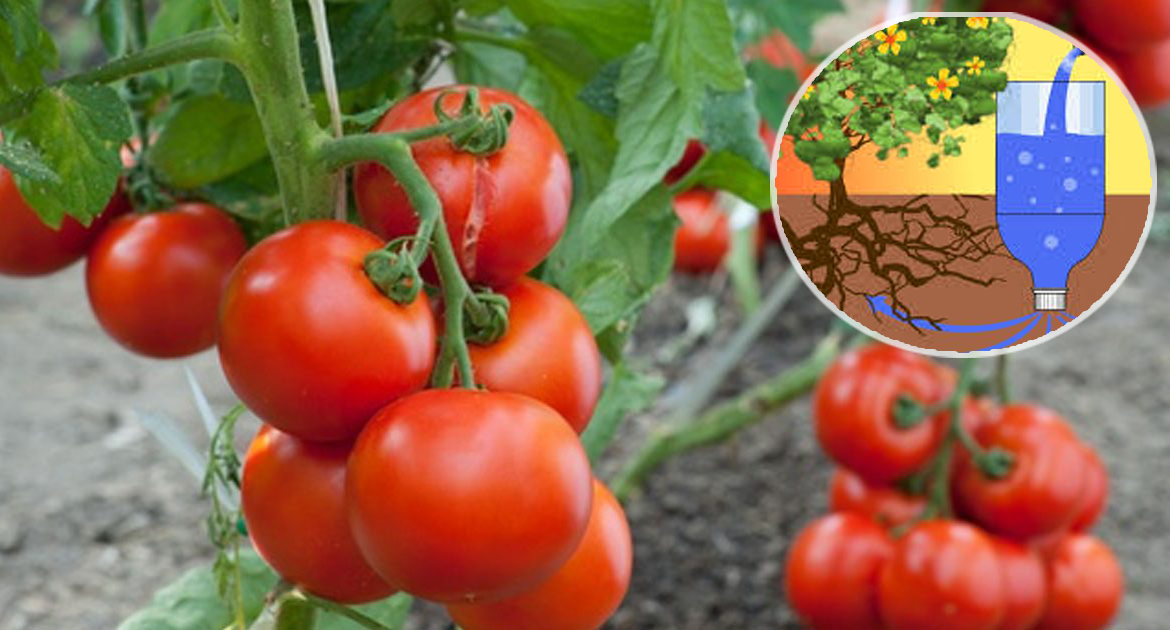
In the presence of a small suburban area the best option for the gardener would be to create drip irrigation with his own hands. After all, such irrigation systems will require a minimum investment of funds, and to create them you can use the materials available at hand.
Benefits of Drip Irrigation for Tomatoes
Arranging a plot with a tomato system for drip irrigation simultaneously solves a large number of tasks:
- Water is consumed more economically and efficiently. The liquid flows exactly in the direction, without wetting the whole soil.
- Saves time and effort.
- The soil is more saturated with water, because excessive moisture does not spread over the surface, longer retaining in the ground.
- The risk of plant damage by pathogenic microbes is reduced, since water does not fall on the foliage and does not create a favorable breeding environment for pathogens.
- Plants with drip irrigation experience less stress even when watering with very cold water.
- Together with irrigation, fertilizing and etching of culture from diseases and pests are successfully organized.
- The root system under drip irrigation develops more powerfully, contributing to the active growth of the vegetative mass.
Variants of making systems do it yourself
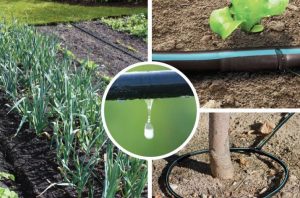 In specialized markets, you can purchase universal kits for the manufacture of a drip system. Such structures after assembly will not differ from the factory samples, however, their cost will be considerable. But you can use the tips and recommendations of gardeners, craftsmen, creating designs from old plastic bottles, medical devices to enter the liquid, clay containers.
In specialized markets, you can purchase universal kits for the manufacture of a drip system. Such structures after assembly will not differ from the factory samples, however, their cost will be considerable. But you can use the tips and recommendations of gardeners, craftsmen, creating designs from old plastic bottles, medical devices to enter the liquid, clay containers.
Standard construction
The manufacture of polypropylene pipe construction for water supply has many advantages. Material differs in the budgetary cost, reliability and a practicality.
What is required:
- metal or plastic capacity of 150 - 200 l;
- locking device for the passage of water and its overlap;
- water purification device;
- plastic pipes without connections with a diameter of 1.5-2 cm - 100 - 200 m;
- old hoses or purchased drip tapes 50 - 100 m;
- connecting elements;
- soldering iron for soldering polymer pipes;
- screwdriver;
- sharp knife.
Manufacturing
Having made the pre-purchase measurements of all the necessary elements, it should be noted that irrigation of 1 square meter with planted tomatoes will require 20-25 liters of water per day and about 2 m of drainage tapes. In order to ensure the supply of water to plants with sufficient pressure, bulk containers with water must be installed one to two meters above the ground level.
Having made a hole in the tank at a height of about 10-15 cm from the bottom, mount the ball valve. Cut the polymer pipes with a sharp construction knife into the necessary lengths, make holes with a screwdriver at a distance of 40 -70 cm. Fix the pipes to the fittings with a soldering iron and wiring to attach branches from the old hose or the acquired drip tape. At the edge of each branch pipe, make a plug of their wooden bars.
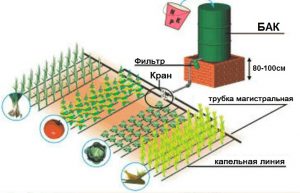 Attach the ends of the branches to the fittings, install a mini-starter splitter or a faucet for the plastic pipe. The design of such connecting elements provides good tightness, and the opening and closing of the crane does not require much effort. In addition, thanks to special regulators, you can smoothly change the amount of water supplied. At the last stage of manufacturing the structure, connect the water supply to the tank, fill it and start drip irrigation.
Attach the ends of the branches to the fittings, install a mini-starter splitter or a faucet for the plastic pipe. The design of such connecting elements provides good tightness, and the opening and closing of the crane does not require much effort. In addition, thanks to special regulators, you can smoothly change the amount of water supplied. At the last stage of manufacturing the structure, connect the water supply to the tank, fill it and start drip irrigation.
Recommendations!
Water filter should be installed on the tank. After all, the unit will retain in itself sand, garbage. Without filtering small particles, the irrigation system will quickly fail.
The use of plastic bottles
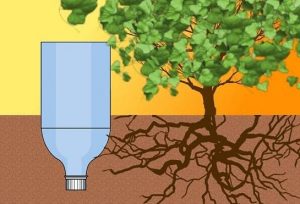 The most budgetary and ordinary method of irrigating tomatoes is to create designs using plastic bottles that accumulate in every home. This method of irrigation does not replace the full moisture of the soil with a strong drought. However, it will be nice to maintain humidity, saving the life of plants.
The most budgetary and ordinary method of irrigating tomatoes is to create designs using plastic bottles that accumulate in every home. This method of irrigation does not replace the full moisture of the soil with a strong drought. However, it will be nice to maintain humidity, saving the life of plants.
Necessary materials:
- plastic bottles in volume from 1.5 to 5 liters;
- needle, needle or nail;
- capron;
- twine;
- geyser plugs.
Dug tanks
Manufacturing
Taking the prepared bottles and the hot object, make holes around the entire circumference, departing from the top and bottom edges of the container 5 cm-10 cm. After digging a hole next to a tomato bush, place a bottle upside down in the bottle. Cover with earth, leaving 15 cm of the upper part. On the container neck, fix a piece of nylon to prevent dirt from entering. With a watering can without a nozzle, pour water into the bottle, which will subsequently be evenly supplied to the root system of tomatoes.
Hanging tanks
To create this design, it is worthwhile to worry in advance about the construction of wooden stakes or metal rods above the bushes with tomatoes, on which a container with water will be mounted. The maximum height of the structures should not exceed 50 cm. Having made holes on the bottle cap with a hot, hot object, the bottom must be cut with a knife. Pierce two holes on the side of the bottle, thread the string and hang it from the construction of stakes. Fill with water, fix a piece of nylon over the top of the tank to prevent debris from entering.
With a geyser stopper for plastic bottles
To create that original design, in specialized markets you need to buy a geyser-watering can, which is twisted on the bottle instead of the cap. The bottom of the container is cut off at will. After all, the advantage of the design is that as soon as the liquid in the tank runs out - you can unscrew it from the geyser head and collect water again. Pre-puncture holes in the bottle, a watering can is put on it, the design is stuck into the ground at a distance of 10 cm from the tomato bush. The only drawback of this system is that the nozzle can be selected only on the bottle of 1l-2.5 liters.
Recommendations!
When creating a drip irrigation system from plastic bottles, you should know that the more holes are made in the tanks, the more drops will fall on the plantations. In this capacity will have to fill with water much more often. An excellent option for installing plastic structures will be the addition of fertilizers and disinfectants to pests and diseases in containers. However, it must be remembered that fertilizing, fungicides and insecticides should be added already in a dissolved form. Dilute drugs should be strictly following the instructions.
Using pottery
The method of point irrigation using clay containers was used thousands of years ago by the Israeli people to irrigate fields. When using this method, much less water is consumed, weeds grow poorly, there are fewer pests.
Necessary materials:
- clay containers of various sizes.
Manufacturing
Clay vessels should be buried in the ground at a distance of 15 cm from the root system of the plant. Small tanks should be buried in the ground for irrigating crops on small raised beds or containers, bury more vessels for irrigating plants on small plots of land. All that needs to be done after digging jugs into the ground is to fill them with water in a timely manner, systematically observing the condition of the tomatoes.
With this method of drip irrigation, all the lateral branches of the root system of tomatoes will intensively reach for the buried vessel with water, weaving it over time, firmly fixing on its outer walls.
Drip irrigation technology using clay vessels helps save up to 60% of water consumed during surface irrigation. To preserve the dishes before the sub-zero temperatures, the pots should be pulled out of the ground, cleaned with soda ash and vinegar, keeping in a dry place until the next season.
Recommendations!
When using the drip irrigation method using clay dishes, fertilizers and disinfectants should not be applied to containers. Therefore, plants should be fed, treated with fungicides and insecticides separately.
Construction of medical droppers
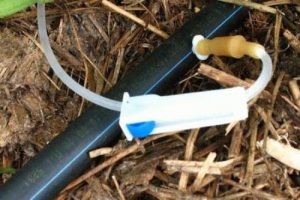 Acupressure irrigation with the help of medical droppers has a similar principle of working with other structures created by yourself. The flow of liquid to the root system of tomatoes in such a system can occur both from the bulk capacity, and immediately from the aqueduct.
Acupressure irrigation with the help of medical droppers has a similar principle of working with other structures created by yourself. The flow of liquid to the root system of tomatoes in such a system can occur both from the bulk capacity, and immediately from the aqueduct.
Necessary materials:
- 100l-200l plastic or metal container;
- polymer pipes for water supply 50m-100m;
- water filter;
- medical devices for administering fluids;
- ball valve;
- plastic caps;
- fitting;
- angle-PND for pipe connections;
- sharp construction knife;
- drill or screwdriver.
System with water tank
After establishing a water supply tank for an elevation of 1m-2m, it is necessary to install a filter and a ball valve in it, retreating 10 cm from the bottom. After installation of the elements, it is necessary to mount the angle-pnd, securing it with a clutch. To one of its edges you need to put on a piece of plastic pipe, and to the second one more corner to connect with the main plastic hose. Counting the number of beds, make the layout, securing the branch fittings.
When the polymer pipes are mounted and laid out throughout the site, you should proceed to the connection of medical devices. Fix the required holes in the hoses with a screwdriver or a drill, fasten the tubes. After the droppers are attached, the needle should be positioned at the base of the tomatoes, and the system wheel should be screwed all the way. Such an action is necessary to test the operation of the structure, after which the required level of water supply is adjusted. For moisture-loving crops you need to adjust a large flow of fluid, for the rest - to reduce the level.
Plumbing system
Drip irrigation of their medical products can be done directly from the water supply system, connecting a hose to it. This method is applicable even in the presence of a large water pressure. After all, waiting until the liquid reaches the most distant point, you can turn off the tap, reducing the water supply. For the manufacture of the structure, lay out polymer pipes or old hoses on the section, do the wiring. Using a screwdriver or a drill, make holes, install droppers.
Stakes system
Manufacturing
Having established stakes with nails hammered into the upper part near the plants, hang out water-filled droppers. Using the wheel to adjust the flow of liquid to the tomatoes.
Recommendations!
It is possible to increase the efficiency of the drip irrigation design from medical devices for the injection of liquid by placing a layer of 15-25 cm around the root system of tomatoes.
Underground system
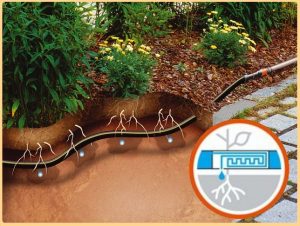 Irrigation under the ground differs from similar drip constructions in that the water is supplied directly to the root system of tomatoes.
Irrigation under the ground differs from similar drip constructions in that the water is supplied directly to the root system of tomatoes.
Necessary materials:
- polypropylene pipes for water supply 100m;
- polyethylene;
- tees;
- plastic caps;
- screwdriver or drill;
- agrofibre or kapron.
Manufacturing
Having dug a trench about 25cm-30cm in depth, you need to lay a plastic film on its bottom. The element will serve as a barrier preventing water from escaping. On the film should lay a layer of small stones, then - polymer hose. For a uniform distribution of fluid, the supply pipe should be exactly in the middle. Having done with a screwdriver or a drill a hole with a diameter of 1.5mm-3mm, put the plugs in, connect to a water supply system or a bulk container with water.
After checking the design, you should wrap the polymer pipe with agrofibre or nylon, cover the trench with soil. Turning the system back on for a few minutes, dig out the ground in several places to check for wetness.
Recommendations!
If there are plants on the site that require irregular irrigation, instead of tees on the underground structure, you can install control valves that will limit the flow of water to individual crops.
Each gardener on the site there are items and parts to create the simplest drip design. Spending on their production a minimum of financial resources, it is possible to achieve excellent results in the cultivation of tomatoes.

